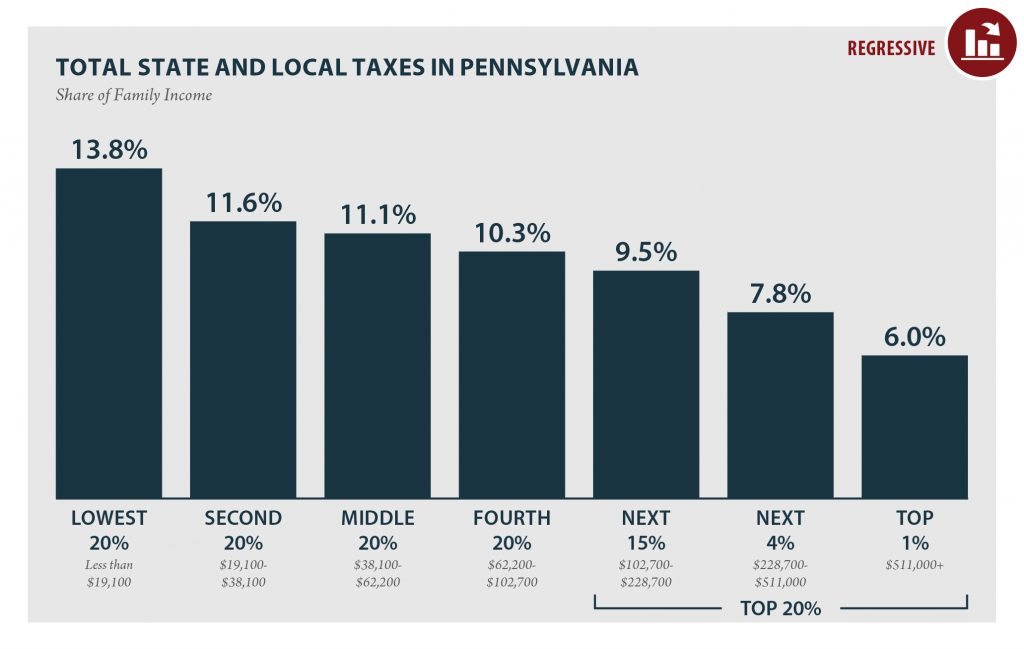POSTED: Wednesday, January 30, 2013, 10:39 AM
Follow on Twitter @DanielDenvir
Pennsylvania is one of the “Terrible Ten” states with the most regressive tax structures nationwide, hitting the poor hardest while taking the least from the rich, according to a new report from the liberal Pennsylvania Budget and Policy Center (PBPC) and the Institute on Taxation and Economic Policy.
“No one would deliberately design a tax system where low-income working families pay the greatest share of their income in taxes, but that is exactly the type of upside-down tax system we have in Pennsylvania,” according to a release from PBPC director Sharon Ward.
Poor Pennsylvanians effectively pay 12 percent of their income in state taxes, middle-income people pay 9.8 percent, and the top 1 percent pay 4.4 percent, the study finds. That means that low-income Pennsylvanians pay taxes at rates nearly three times as high as their 1 percenter counterparts.
(The study was limited to non-elderly taxpayers, because older residents are often subject to very different tax treatment than everyone else.)
Pennsylvania, according to the study, has the ninth-highest tax rate on the poor of any state nationwide.
And they don’t get much for their money: Gov. Tom Corbett has cut public basic and higher education by $1 billion, heavily cut into county programs for the poor and disabled, and entirely eliminated cash General Assistance welfare.
Meanwhile, critics fault Corbett for: extending major tax breaks to energy companies making dubious job-creation pledges; failing to close the “Delaware loophole” that allows companies with shells you-know-where to evade paying state taxes here; and finally, only after great delay, imposing a rock-bottom “impact fee” on the state’s booming natural gas industry. He has, incidentally, received rather friendly treatment from energy heavyweights, including one who might be getting away with environmental wrongdoing.
OK, back to the study.
Income taxes are typically progressive because they tax people at different rates depending on how wealthy they are. While super-regressive states like Florida, South Dakota, Texas and Washington have no personal income tax at all, Pennsylvania — like Illinois and Indiana — apply a flat income-tax rate to poor and rich alike. Most states that have income taxes have graduated tax rates that apply to different income levels. Not here. And it gets worse.
In Pennsylvania, the poorest pay 5.7 percent of their income in sales and excise taxes, while the top 1 percent pay just 0.6 percent. Meanwhile, the middle 20 percent pay 3.8 percent of their income in state income taxes, compared to just 3.2 percent paid the top 1 percent.
Pennsylvania typically ranks high on lists of bad things, amongst the Alabamas of the United States (just kidding folks: my mom’s from Birmingham, and I love Alabama). But it’s really a nationwide problem.
“The main finding of this report is that virtually every state’s tax system is fundamentally unfair, taking a much greater share of income from middle- and low-income families than from wealthy families. …Combining all of the state and local income, property, sales and excise taxes state residents pay, the average overall effective tax rates by income group nationwide are 11.1 percent for the bottom 20 percent, 9.4 percent for the middle 20 percent, and 5.6 percent for the top 1 percent.”
Last week, The New York Times reported that Republican governors nationwide are aiming to make things even more unequal by abolishing their states’ income taxes and increasing regressive sales taxes. Many economists do indeed like the idea of taxing consumption instead of income.
But in Europe, a region where high value-added taxes are generally imposed, poor and middle class people get a lot more in return for the money they hand over to government. They, The Times’ Eduardo Porter points out, get a real-deal welfare state. “Europe’s social democracies compensate for the regressive nature of the tax by spending the money on benefits that are particularly valuable for the poor.”





